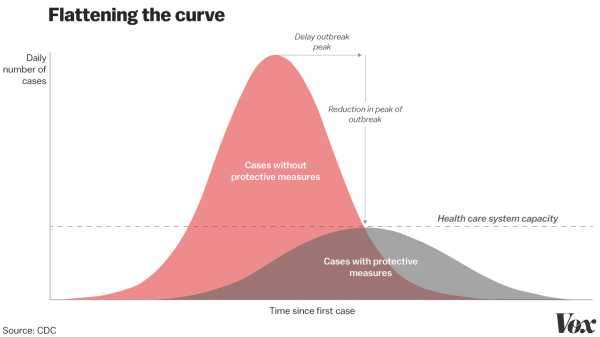
As confirmed cases of the novel coronavirus continue to increase across the United States — there are, as of March 14, over 2,000 reported cases across 49 states — one of the biggest issues doctors could face is simply finding space to treat patients requiring medical assistance.
There is some question as to whether the US has enough hospital beds to treat all those who could become infected. Available data on hospital capacity suggests the country does not.
According to the Organisation for Economic Co-operation and Development, the US has 2.8 hospital beds per 1,000 people. By contrast, other countries with serious coronavirus outbreaks have more on average: China has 4.3, South Korea has 12.3, and Italy has 3.2 per 1,000 people.
Despite this, all have had difficulties handling their respective influxes of infected people at hospitals. In Italy, which has been hit particularly hard, doctors and hospitals have become so overwhelmed that the Italian College of Anesthesia, Analgesia, Resuscitation and Intensive Care has published guidelines calling for doctors to approach patients with a wartime triage sensibility; and it has discussed a potential age limit for access to care.
One advantage the US has over the Italian health care system is a greater number of intensive care unit (ICU) beds. But while the US has more ICU beds than European countries do on average, the availability of those beds is still deeply concerning. “It’s estimated that we have about 45,000 intensive care unit beds in the United States. In a moderate outbreak, about 200,000 Americans would need one,” Aaron Carroll, a professor at the Indiana University School of Medicine and analyst for the New York Times, recently wrote.
USA Today said that its most “conservative” analysis based on data from the American Hospital Association, US Census, CDC and World Health Organization found that “there could be almost six seriously ill patients for every existing hospital bed.” But that estimate, which assumes an infection rate similar to ordinary infection rates of the flu, is based on the idea that all hospital beds would be empty. In reality, two-thirds are generally full. With that occupancy rate taken into account, there would be 17 patients per open bed.
One reason so many beds are currently occupied is that hospitals across the US are already working to treat flu patients. The coronavirus pandemic has coincided with the tail end of peak flu season, which continues through March. Anthony Fauci, director of the National Institute of Allergy and Infectious Diseases at the National Institutes of Health, has said this year’s flu is on track to be as bad as the 2017-2018 season, the most lethal in a decade. This means hospitals are already eating into some of their “surge capacity” — their ability to absorb a big increase in the volume of patients — and that bed availability is particularly limited currently.
These statistics may sound grim, but are only cause for concern — not alarm. There are a number of measures that can be taken both on the governmental and personal levels that can help ensure hospital capacity does not become an issue.
For instance, China has shown that it’s possible to mitigate bed limitations by rapidly building hospitals to meet demand. And putting into practice the “social distancing” (essentially avoiding nonessential social interaction) the CDC has recommended could not only dramatically slow the spread of disease, but could also reduce the odds that the number of people needing coronavirus treatment surges past hospital capacity.
China built hospitals to treat coronavirus victims quickly
The novel coronavirus was first reported in China, and the country has pursued containment and mitigation efforts aggressively. One of those tactics included building hospitals packed with beds extremely quickly.
The city of Wuhan, where the coronavirus first started, built two makeshift hospitals to offer 2,000 additional beds to sick people in just weeks. Construction teams of some 7,000 workers built the facilities at a breakneck pace, and the hospitals were designed to be used exclusively for patients with confirmed cases of coronavirus.

In its assessment of China’s response to the novel coronavirus, the World Health Organization cited the construction of new hospitals as a key initiative that helped save lives in China.
The Trump administration has not signaled any plans to launch a similar initiative in the US, and given the reticence of some Republican lawmakers to approve additional anti-coronavirus spending in recent weeks, any proposal to build new hospitals could face some congressional censure. But there is also plenty of precedent for the US government being aggressive about producing materials for crisis.
For example, during World War II the US transformed automobile factories into efficient producers of aircraft, tanks, trucks, and guns to help with the war effort. It’s certainly possible for the government to take a similar attitude toward directly working to make sure hospitals are adequately equipped to deal with a potential surge in visits to ICUs.
Social distancing could help hospitals manage patient care
According to the Harvard Global Health Institute, the coronavirus could end up causing between 10 million and 34 million hospital visits — and about a fifth of those patients will require intensive care.
In light of the fact that there isn’t enough space in hospitals to deal with an explosive outbreak, it’s important to do what can be done to slow transmission. As Carroll summed it up in the Times: “A crucial thing to understand about the coronavirus threat — and it’s playing out grimly in Italy — is the difference between the total number of people who might get sick and the number who might get sick at the same time.”
And public behavior is going to play a big factor in determining if and when there’s a huge surge beyond the health care system’s capacity.
Experts say social distancing and hygienic practices like methodically washing one’s hands and cleaning potentially infected surfaces could slow the pace at which coronavirus spreads through the population, if enough people observe these practices. This in turn could “flatten the curve” of new coronavirus cases, ensuring that hospital capacity isn’t dramatically exceeded:

Epidemiologists use the term social distancing for efforts to reduce close contact between people that could accelerate the spread of disease. That means everything from keeping a distance of at least 6 feet from other people in public to avoiding crowded gatherings like concerts. Research indicates cities that aggressively implement social distancing rules historically have slowed the transmission of the flu among their residents and saved lives in the process.
Experts say Covid-19 will be much more manageable if the hospital system isn’t overwhelmed. It’s incumbent on the government and its citizens to take whatever steps they can to ensure that doesn’t happen.
Sourse: vox.com






